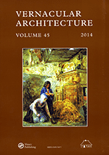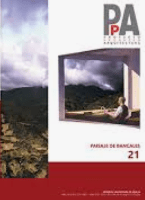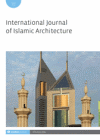
Cuaderno de Notas
Scope & Guideline
Connecting Global Artistic Innovation with Local Insights
Introduction
Aims and Scopes
- Architectural Historiography:
The journal focuses on the historical analysis of architecture, exploring various architectural movements, figures, and their contributions to the field. - Interdisciplinary Methodologies:
It employs a range of methodologies, including critical theory, semiotics, and cultural studies, to analyze architectural practices and their societal implications. - Contemporary Architectural Critique:
Cuaderno de Notas is committed to critiquing contemporary architectural practices, examining their theoretical foundations and societal impacts. - Didactic Projects and Education:
The journal also highlights the role of education in architecture, analyzing teaching methods and academic contributions to the field. - Cultural and Geographic Context:
Papers often explore architecture within specific cultural and geographic contexts, providing insight into local practices and influences.
Trending and Emerging
- Sustainability and Environmental Impact:
There is an increasing emphasis on sustainability within architectural practices, reflecting global concerns about climate change and the need for eco-friendly design solutions. - Gender and Architecture:
Emerging discussions around gender roles in architecture, including studies of contributions from women architects, indicate a growing awareness and critique of gender dynamics in the field. - Memory and Commemoration:
The theme of memory, particularly in relation to memorial architecture and spaces of remembrance, has gained prominence, showcasing architecture's role in cultural identity and historical narrative. - Interdisciplinary Approaches:
The incorporation of interdisciplinary perspectives, such as sociology and philosophy, into architectural analysis is trending, highlighting the interconnectedness of architecture with broader societal issues. - Digital Architecture and Technology:
With advancements in technology, there is a rising interest in digital architecture, exploring how digital tools and methods influence design processes and outcomes.
Declining or Waning
- Traditional Architectural Styles:
There has been a noticeable decrease in discussions surrounding traditional architectural styles, as the focus shifts towards modern and contemporary interpretations. - Local Case Studies:
Papers centered on localized case studies have diminished, indicating a broader trend towards global architectural discourse rather than regional specifics. - Historical Preservation Practices:
Themes related to historical preservation are less frequently addressed, possibly overshadowed by more contemporary concerns regarding sustainability and innovation.
Similar Journals

ARCHITECTURAL RECORD
Illuminating Architectural Insights and PracticesARCHITECTURAL RECORD, published by McGraw Hill Inc, stands as a vital resource in the field of architecture and design, offering insightful perspectives and critical analyses that cater to architects, designers, and academia alike. With an ISSN of 0003-858X, this prestigious journal has been a cornerstone for the architectural community, providing a blend of contemporary practices and theoretical frameworks since its inception. Although it is not currently available through Open Access, its rich content contributes to the ongoing dialogue in both the Visual Arts and Performing Arts, as well as Engineering and Architecture disciplines. The journal's historical impact can be seen through its wide readership and influence in shaping architectural discourse, making it a highly regarded publication for professionals and students in the field. As a beacon of innovative practices, ARCHITECTURAL RECORD continues to inspire and educate, even despite its coverage discontinuation in Scopus since 2018.

En Blanco-Revista de Arquitectura
Showcasing Cutting-Edge Research in ArchitectureEn Blanco - Revista de Arquitectura is a peer-reviewed journal published by UNIV POLITECNICA VALENCIA, EDITORIAL UPV, specializing in the field of architecture and design. This esteemed publication aims to bridge theoretical advances and practical applications within the architecture domain, showcasing innovative research, critical essays, and multidisciplinary approaches. With an emphasis on fostering dialogue among researchers, professionals, and students, En Blanco serves as an essential platform for disseminating cutting-edge ideas and discussions that define contemporary architectural practices. Although currently offering non-open access content, the journal is dedicated to promoting accessibility through insights that resonate beyond its pages. With an ISSN of 1888-5616 and E-ISSN of 2445-1215, En Blanco is a pivotal resource for any architecture enthusiast looking to enrich their understanding and contribute to the evolving discourse in architectural studies.

Zograf
Fostering academic excellence in the heart of Serbia.Zograf is a distinguished open-access journal published by the University of Belgrade's Institute of Art History, Faculty of Philosophy, dedicated to the fields of Archeology, History, and Visual Arts and Performing Arts. With an ISSN of 0350-1361 and an E-ISSN of 2406-0755, Zograf has made substantial contributions to research within its domain since transitioning to open access in 2002. Situated in Serbia, the journal has achieved notable recognition, ranking in the Q1 category for both History and Visual Arts and Performing Arts, and in the Q2 category for Archeology in the recent 2023 evaluations. This positioning underscores its significance and influence among peers, making it an invaluable resource for researchers, academics, and students alike. The journal's commitment to disseminating high-quality scholarship facilitates interdisciplinary dialogue and advances knowledge in the humanities, while its open-access model ensures that research is freely available to a global audience. Zograf's editorial board comprises leading scholars who are dedicated to promoting innovative research that inspires future generations of scholars.

Vernacular Architecture
Illuminating the Intersection of Culture and ConstructionVernacular Architecture, published by ROUTLEDGE JOURNALS, TAYLOR & FRANCIS LTD, is a pivotal scholarly journal dedicated to the study and preservation of traditional architectural practices. With its ISSN 0305-5477 and E-ISSN 1749-6292, this esteemed journal has been at the forefront of research from 1971 to 2023, providing a platform for interdisciplinary discourse among architects, historians, and conservationists. The journal holds noteworthy rankings, placing in the Q4 quartile for Architecture and making significant strides in related fields, including Conservation, History, and Visual Arts. As a vital resource with a current Scopus rank of #142 in Visual Arts and Performing Arts, it not only reflects the rich fabric of architectural heritage but also stimulates innovative approaches to contemporary building practices. Although not open access, it remains indispensable for those who wish to explore the nuances of vernacular forms and their cultural significance. Experience the convergence of scholarship and practice in Vernacular Architecture, a journal that champions the essence of place and identity in the built environment.

ABE Journal
Advancing Knowledge in Art and Visual CultureABE Journal, ISSN 2275-6639 (E-ISSN 2275-6639), is an esteemed open-access publication emerging from the collaborative efforts of INVISU-CNRS-INHA and the Institut National d'Histoire de l'Art located in Paris, France. Since its inception in 2012, the journal has facilitated unrestricted access to groundbreaking research in the fields of art history and visual studies, making significant contributions to interdisciplinary scholarship. With a commitment to disseminating high-quality research, ABE Journal plays a crucial role in fostering dialogue among scholars, practitioners, and students alike. Its diverse range of articles underscores the innovation and evolution within the art historical discourse, as it seeks to engage an international audience eager to explore contemporary methodologies and practices. The journal not only enhances accessibility to vital research but also aims to elevate academic standards within its field, making it a vital resource for those seeking to stay at the forefront of art history and visual culture.

Boletin Academico-Revista de Investigacion y Arquitectura Contemporanea
Pioneering Research at the Intersection of Art and Architecture.Boletin Academico-Revista de Investigacion y Arquitectura Contemporanea is a distinguished journal published by SIELAE & UNIV CORUNA, Fac Filologia, focusing on the interconnectivity of contemporary architecture, cultural studies, and visual arts. With an E-ISSN of 2173-6723, this open-access publication serves as an essential resource for researchers, academics, and professionals eager to explore innovative perspectives and methodologies in these dynamic fields. Spanning a commendable period from 2016 to 2023, the journal demonstrates a strong academic footprint, ranked in the Q2 category for both Architecture and Cultural Studies, and holds a prestigious Q1 ranking in Visual Arts and Performing Arts. With Scopus rankings reflecting its growing influence—particularly in Visual Arts and Architecture—Boletin Academico delivers a platform that is not only academically rigorous but also culturally relevant, encouraging discourse that shapes the future of contemporary architectural and artistic practices. The journal’s commitment to open access further enhances its appeal, ensuring that groundbreaking research is readily available to an extensive audience.

ArcHistoR-Architecture History Restoration
Preserving Heritage, Inspiring InnovationArcHistoR-Architecture History Restoration is an esteemed open-access journal published by UNIV MEDITERRANEA REGGIO CALABRIA since 2014, focused on the multifaceted domains of architecture, history, and visual arts. This journal serves as a vital platform for the dissemination of research findings, innovative methodologies, and critical discussions surrounding the restoration and history of architectural practices, appealing to a diverse audience of researchers, professionals, and students in these fields. With a commitment to scholarly excellence, ArcHistoR has positioned itself within the academic community, reflected in its ranking in the 2023 category quartiles, where it secured Q4 in Architecture and Q3 in both History and Visual Arts and Performing Arts. The journal facilitates global collaboration and knowledge sharing in its areas of expertise, further underscoring its relevance and significance. Based in Italy, effective communication and cooperation in the restoration community can flourish through the journal's purview. For those dedicated to expanding their understanding and contributing to the discourse on architectural history and restoration, ArcHistoR is an invaluable resource.

Festival dell Architettura Magazine
Showcasing Emerging Voices in Architecture and PerformanceFestival dell Architettura Magazine, published by FESTIVAL ARCHITETTURA EDIZIONI, is a distinctive Open Access journal dedicated to the realms of architecture, urban studies, and the visual and performing arts. Established with a vision to foster interdisciplinary dialogue, the journal has been a part of the academic landscape since 2013 and has converged its insightful contributions from 2018 to 2023. Despite being ranked in the lower quartiles in its respective categories—Q4 in Architecture and Urban Studies, and Q3 in Visual Arts and Performing Arts—this publication remains vital for emerging researchers and seasoned professionals alike, as it provides a platform for innovative ideas and practices from Italy and beyond. It serves as a key resource for those who wish to engage with contemporary architectural thought and cultural expressions, facilitating open access to research that highlights the intersections of space, society, and art.

Proyecto Progreso Arquitectura
Elevating scholarly dialogue in architecture and visual arts.Proyecto Progreso Arquitectura, an esteemed academic journal published by UNIV SEVILLA, EDITORIAL, is dedicated to advancing the fields of Architecture, Arts and Humanities, History, Urban Studies, and Visual Arts. With an Open Access model since 2010, this journal facilitates the dissemination of innovative research and critical discourse among a global audience, fostering collaboration and insight within the academic community. Operating from Seville, Spain, the journal has successfully carved a niche in the architectural and design studies landscape, currently positioned in the Q3 category in Architecture and Urban Studies, and Q2 in History and Visual Arts as of 2023, demonstrating its growing impact and reputation. With an ISSN of 2171-6897 and an E-ISSN of 2173-1616, it also ranks commendably in Scopus across various disciplines, offering readers an invaluable resource for scholarly articles that contribute to the vibrant dialogues in architecture and its intersection with societal developments. The journal's approach not only encourages academic rigor but also embraces the practical implications of research, making it an essential read for researchers, practitioners, and students alike.

International Journal of Islamic Architecture
Bridging Cultures Through Architectural InnovationThe International Journal of Islamic Architecture, published by INTELLECT LTD in the United Kingdom, is a pivotal scholarly resource dedicated to the exploration of Islamic architecture, design, and cultural expressions within a contemporary framework. With ISSN 2045-5895 and E-ISSN 2045-5909, this journal targets an interdisciplinary audience by bridging the gap between architecture, geography, urban studies, and the arts. Established in 2012, it has swiftly garnered recognition, achieving notable rankings such as Q3 in Architecture and Q2 in Visual Arts and Performing Arts by 2023. Although it currently does not offer open access, its articles are meticulously peer-reviewed, ensuring high academic standards and relevance. Emphasizing the significance of Islamic architectural heritage in global contexts, the journal seeks to foster innovative perspectives and critical discourse, making it an essential platform for researchers, professionals, and students alike to engage with contemporary architectural practices and cultural dialogues.